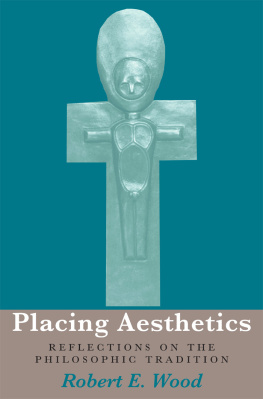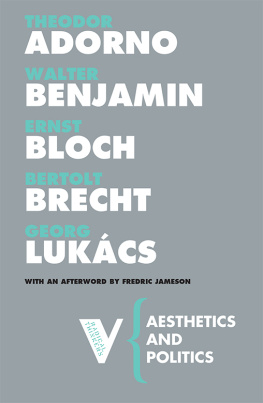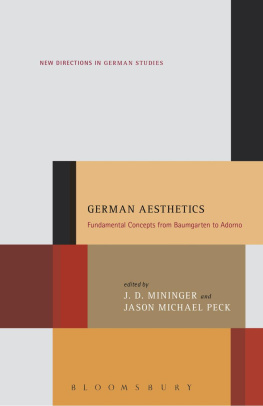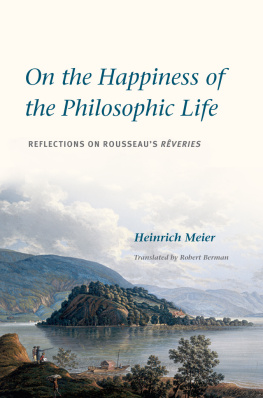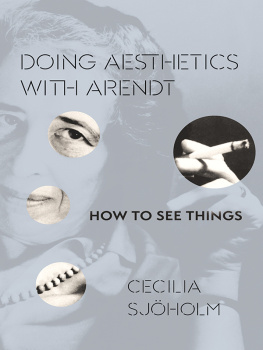PLACING AESTHETICS

PLACING AESTHETICS
Reflections on the Philosophic Tradition
Robert E. Wood
OHIO UNIVERSITY PRESS
Athens
Ohio University Press, Athens, Ohio 45701
1999 by Robert E. Wood
Printed in the United States of America
All rights reserved
Ohio University Press books are printed on acid-free paper 
03 02 01 00 99 5 4 3 2 1
Library of Congress Cataloging-in-Publication Data
Wood, Robert E., 1934
Placing aesthetics : reflections on the philosophic tradition / Robert E. Wood.
p. cm. (Series in Continental thought ; 26)
Includes bibliograhical references and index.
ISBN 0-8214-1280-9 (alk. paper).
ISBN 0-8214-1281-7 (pbk. : alk. paper)
1. AestheticsHistory I. Title. II. Series.
BH81.W66 1999
111'.85'09dc21
99-27142
CIP
Frontispiece. Christus Africanus by Robert E. Wood
To Sue,
who, given but half a life, died at peace
and to Jim,
who, given two-thirds of a life, lived enough for three.
Contents
Abbreviations
Aquinas
| ST | Summa theologiae |
Aristotle |
| NE | Nicomachean Ethics |
| OS | On the Soul |
Dewey |
| AE | Art as Experience |
| ExN | Experience and Nature |
| FATE | From Absolutism to Experimentalism |
| RP | Reconstruction in Philosophy |
Hegel |
| ALFA | Aesthetics: Lectures on Fine Art (Knox trans.) |
| EL | Encyclopaedia Logic |
| HPM | [Hegels] Philosophy of Mind |
| PR | [Hegels] Philosophy of Right |
| PS | Phenomenology of Spirit |
| SL | The Science of Logic |
Heidegger |
| BAT | Being and Time |
| BDT | Building, Dwelling, Thinking, in PLT |
| EP | The End of Philosophy |
| IM | An Introduction to Metaphysics |
| LH | Letter on Humanism, in Basic Writings |
| LP | Language in the Poem, in OWL |
| MA | Memorial Address |
| NL | The Nature of Language, in OWL |
| OWA | The Origin of the Work of Art, in |
| OWL | On the Way to Language |
| PLT | Poetry, Language, and Thought |
| QCT | The Question Concerning Technology |
| WCT | What Is Called Thinking? |
| WP | What Is Philosophy? |
| WPF | What Are Poets For? in PLT |
Kant |
| CJ | Critique of Judgment |
| CPR | Critique of Pure Reason |
Nietzsche |
| BGE | Beyond Good and Evil |
| BT | The Birth of Tragedy |
| EH | Ecce Homo |
| GM | On the Genealogy of Morals |
| GS | Gay Science |
| TI | Twilight of the Idols |
| TSZ | Thus Spake Zarathustra |
| WTP | The Will To Power |
Plato |
| Rep | The Republic |
| Sym | Symposium |
Plotinus |
| Enn | The Enneads |
Schopenhauer |
| EA | Essays and Aphorisms |
| WWR | The World as Will and Representation |
Preface
The origins of this book are multiple: a love of solitude, of woods and mountains and clouds and fields, of the changing moods on the surface of the water, of the play of light and deepening shadow on brush and timber in late afternoon; a love of the shape and color of bleached bones, slightly porous, dull white; a love of smooth, shiny stones and shells gathered along the shores of Lake Michigan and the Pacific Ocean; the experience of being arrested from time to time by the realization of my own mortality; a few fleeting moments of the sense of eucharistic presence; the experience of the look of the human otherthe absence-in-presence of the conscious person in the sensory gleam of that most fascinating of objects, the human eye, whose presence announces an absence that is more present than all objects; the sense of the endless and the encompassing in the open expanses of Lake Michigan, the Mediterranean Sea, and the Atlantic and Pacific Oceans as well as in the contemplation of the starry skies above; the sense of the virtual omnipresence of life by its absence atop high mountains; the sense of austerity in the desert surrounding the Dead Sea viewed from Masada; the sense of the sacred in the foothills of Parnassus at Delphi; the sense of the presence-in-absence of those long dead at those same sites.
Then there was the reappearance of mortality in Rachmaninoffs Isle of the Dead, together with Arnold Bcklins painting of the same title: the rhythm of the waves washing against the islands shores mirroring the even deeper insistence of the rhythms of life moving toward death, the stern announcement of necessity and the lyrical, serene voice of acceptance; the reappearance of bones, trees, and mountains in the paintings of Georgia OKeefe and the sculpture of Henry Moore, and of cypress trees, fields, rocks, and stars playing in relation to houses and people in van Gogh; the intertwining of people and landscape in Brueghel; the starkness of Grne-walds crucifixion; the piercing presence of Zeus-Poseidon in the bronze attributed to Phidias at the Athens museum; the power of Michelangelos Moses at San Pietro in Vincoli in Rome and of his David in the Accademia in Florence; the elegance of the bronze busts of Benin and the expressiveness of the Yoruba akuaba fertility doll; the sense of cradling in the Piazza Navona in Rome; the soaring heights and rhythmic coordinations of San Pietro in the Vatican, Cologne Cathedral, St. Vitus Church in Hradany Castle in Prague, and Notre Dame in Paris. Earlier there was the music of Tchaikovsky, Rachmaninoff, and Beethoven; then of Sibelius, Shostakovich, and Stravinsky; and later of Mozart, Bach, and Vivaldi: music of longing and striving, of the brooding presence of nature, of discordance and resolution, of joy and energy; but also the simple, serene but soaring spirituality of Gregorian chant; and the mix of presence and loss in the nature poetry of Blake, Keats, Wordsworth, and Hopkins.
One semester I spent all my free time making my way through western Europe. In addition to traveling along some of the great rivers, lakes and mountainson one occasion climbing the face of the Gaisberg outside Salzburgtime spent lingeringly contemplating the churches and galleries of the great cities gave me a special taste for sculpture, particularly bronzes. Upon my return to America I decided to enroll in courses on clay sculpture. Subsequently I produced about four dozen pieces, the best of whichappearing on the cover of this bookI finally had cast in bronze. In addition to an enhanced sensitivity to form and texture, this gave me an appreciation of the process of artistic production. I include in an epilogue a description of that process, along with some general comments on the nature of sculpture that I learned from working, viewing, reading, and reflecting on the art form.

